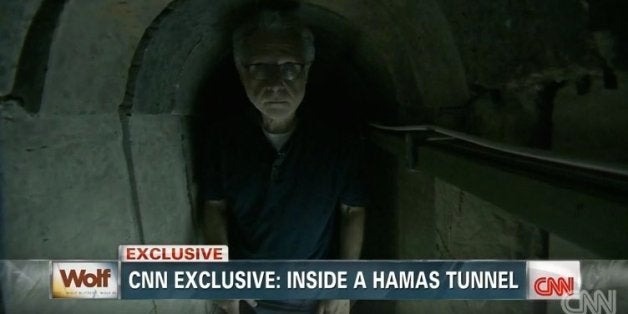
NEW YORK -- Israel has opened up a new front in the Gaza media war by allowing foreign journalists into Hamas-built tunnels running under its border.
The media tours have provided a new perspective on the three-week military conflict, while also drawing criticism that Israel may be exaggerating the threat to its citizens in order to justify its invasion. Over 1,100 Palestinians have died so far, with foreign journalists chronicling civilian casualties and the destruction of Gaza in real time over social media. Several commentators have recently suggested that Israel, which has lost over 50 soldiers, is losing the media battle that has run alongside the actual one.
Israeli officials now typically offer two primary reasons for the invasion of Gaza: to stop Hamas militants from shooting rockets into Israel and to destroy Hamas' network of tunnels. With Israel’s Iron Dome defense system intercepting most missiles, there are few images demonstrating that threat -- even as the pictures of destruction in Gaza flood the Internet. The tunnels, however, offer visuals that make for good television and could potentially bolster Israel's case.
Capt. Eytan Buchman, a spokesman for the Israel Defense Forces, told The Huffington Post that the “tunnels are one of the two main strategic assets that Hamas uses to pose a serious threat to Israeli civilians.”
Buchman said that the IDF couldn’t bring journalists to the tunnels earlier for security reasons. Doing so now, he said, "is an effort to convey the scope of the threat we're facing."
On Friday, the IDF brought a small pool of international journalists into a 6-foot-by-2-foot tunnel that runs nearly two miles under the border between Gaza and southern Israel. The New York Times published a story off a pool report of the visit.
CNN’s Wolf Blitzer scored the first U.S. television tour for a Monday segment, with scenes of the visit running throughout the day on the network. The IDF was clearly pleased with the coverage, as spokesman Lt. Col. Peter Lerner tweeted:
The BBC's Orla Guerin took viewers in the U.K. inside a tunnel on Tuesday.
And Jodi Rudoren, the Jerusalem bureau chief for The New York Times, took her own trip into a Hamas tunnel for an article running on Tuesday’s front page. In the article, Rudoren noted that "Israeli political and military leaders mention the tunnel threat nearly every time they speak" and that the military's invitations to journalists were "part of the propaganda push."
In a Tuesday interview on WNYC’s "The Takeaway," Rudoren was asked if Israel wants people in the United States, and specifically readers of the Times, to see that there's a threat not only from the air but also underground. Rudoren acknowledged that "the Israelis are pushing the tunnel story," but stressed that she requested access.
"I think that they, probably rightly, feel like for all of the horrific images that people around the world are seeing of the devastation and death being wrought on Gaza, that there is a sympathy around the world for the idea that your enemy shouldn't be able to tunnel into your territory and attack people," Rudoren said
"So, yeah, they're certainly pushing it, but I don't think they're pushing it in some way that has nothing to do with something real," she continued. "It really is what they're afraid of."
Some journalists and Israel-Palestine watchers have questioned whether journalists visiting the tunnels are being appropriately skeptical of the IDF's claims.
Greg Mitchell, an author and former editor of Editor & Publisher magazine, wrote on his blog Tuesday that "the tunnels are being used as a pretext for mass slaughter -- and accepted or promoted as much by the U.S. media." Mitchell wrote that journalists haven't adequately challenged Israel's claims about the tunnel threat, which "must be proven and very clear."
Yousef Munayyer, the executive director of the Palestine Center, a think tank, said Tuesday on MSNBC that the media's framing of the "terror tunnels" is misleading because they’ve been used in operations against "primarily, if not exclusively, military targets," rather than to terrorize civilians.
Munayyer later told HuffPost that journalists need to be skeptical of the narrative that the Israeli military is promoting. Too often, he said, "you end up seeing more or less a regurgitation of it than a critical assessment."
"It's great the Israelis are giving you access to their tunnels that your viewers have never seen before," he said. "But is there more to the tunnel story than what the Israelis want you to see?"
